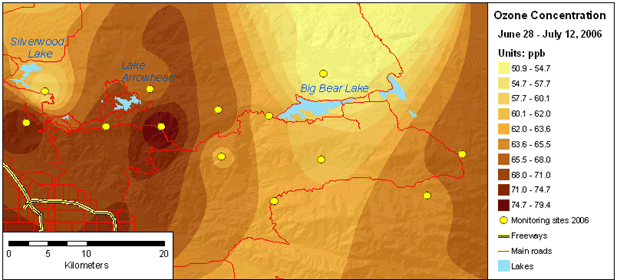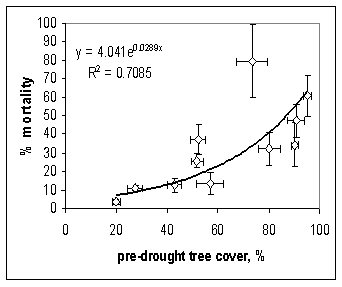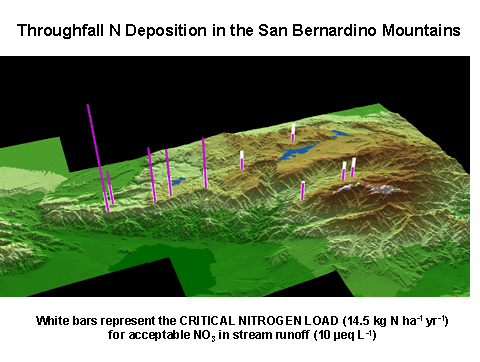Climate Change and...
Case studies
Web sites
Air Pollution and Climate Change
Preparers: Nancy Grulke, Project Leader, and Susan Schilling, Computer Specialist, AtmosphericDeposition on Western Ecosystems, Pacific Southwest Research Station
Issues
Non-CO2 air pollution (such as ozone (O3), nitrogen (N), particulates) is anunder-acknowledged component of climate change.
Ozone is a secondary product of fossil fuel combustion. Although the effect ofO3 on ecosystem carbon sequestration has been recently highlighted(Sitch et al. 2007), high concentrations of tropospheric O3 arewidely viewed as an urban problem. The current global troposphericO3 concentration is already double that of preindustrial times,however, and is expected to increase by an additional 50 percentby 2020.
Excessive nitrogen (N) deposition, a byproductof fossil fuel combustion, animal husbandry, and intensive useof fertilizers, is persistently nudging ecosystem processes alongunknown paths and leading to deterioration of downstream waterquality.
Airborne particulates come from many sources,including secondary pollutants formed by chemical reactions ofpollutant gases, dust particles discharged from road surfaceby traffic, and particles emitted by industrial and agriculturalactivities. Fine particulates (2.5 micrometers in diameter orsmaller) are known to harm human health. Recently fine particulateshave been shown to decrease precipitation in areas downwind oftheir production. Fine particulates have also been shown to reducephotosynthetic activity and ultimately growth of plant speciesendemic to calcareous soils.
Likely changes
Research indicates forests in southern California will becomemore susceptible to wildfire as air pollution increases.
Scientists at the Pacific Southwest Research Station have developedinexpensive air monitoring techniques for measuring O3 levelsover remote forested areas and have mapped areas at greatestrisk. They have found that high concentrations of O3 increasetranspiration and thus exacerbate tree drought stress, increasingvulnerability to insect attacks and wildfire.

Figure 1—Pollution gradient acrossthe San Bernardino Mountains. Contributed by Andrzej Bytnerowicz.
Further research indicates (1) O3 exposuremay negate the positive effects of increased atmospheric CO2on plant growth and (2) moderately high O3 concentrations (inexcess of 70 parts per billion [ppb]) increases plant water lossand risk of drought stress. These observations have been madeat the leaf level and support the whole ecosystem flux observationsat the AspenFACE experiment in northern Wisconsin (Karnosky etal. 2005), and the CASIROZ experiment in southern Germany (Matysseket al. 2007).
Related research indicates that long-termN deposition in the mountains east of Los Angeles has contributedto stand densification, increased the level of drought stress,exacerbated the level of tree mortality during the recent drought,and has significantly contributed to poor stream water quality.
Figure 2 illustrates the level of tree mortality expected withincreasing stand density. These data were collected from aerialimagery from 11 stands in the San Bernardino Mountains in 1994(predrought) and 2004 (postdrought), and indicate that low mortalityrates can result if tree canopy cover (and density) is kept low(<15percent) even during a severe 4-year drought (1999-2002). Twoof the stands with the lowest mortality had prescribed burnsprior to the drought.

Figure 2—Increased tree cover washighly correlated with tree mortality after 4 years of droughtstress. Contributed by Nancy Grulke and Rich Minnich.
Climate change will affect both the inputsand outputs of N from forests and other ecosystems. The dynamicsof nitrate export in streamwater and groundwater is expectedto change. Peak concentrations of nitrates in streamwater arelikely to increase if runoff flows increase owing to a greaterproportion of precipitation occurring as rainfall as opposedto snow, or as a result of more rapid snowmelt, or both.

Figure 3—Nitrogen deposition acrossthe San Bernardino Mountains measured by “throughfall,” thehydrologic flux of nutrients from the canopy to the forest floor.The pinkbars represent total N deposition at each site in microequivalentsper liter, whereas white bars indicate the level of N depositionthat results in unacceptably high nitrate levels in streamwater.
Options for Management
Where forests are strongly affected by airpollution and drought, the key to their management is to thinstands, bothfor waterconservation and to improve carbon sequestration via increasedindividual tree production.
Recommended Reading
Bytnerowicz, A.; Omasa, K.; Paoletti, E. 2007. Integrated effectsof air pollution and climate change on forest: a northern hemisphereperspective. Environmental Pollution. 147: 438-445.
Fenn, M.E.;Poth, M.A.; Aber, J.D.; Baron, J.S.; Bormann, B.T.; Johnson,D.W.; Lemly, A.D.; McNulty, S.G.; Ryan, D.F.; Stottlemeyer,R. 1998. Nitrogen excess in North American ecosystems: predisposingfactors, ecosystem responses, and management strategies. EcologicalApplications. 8: 706-733.
Fenn, M.E.; Poth, M.A. 1999. Temporaland spatial trends in streamwater nitrate concentrations inthe San Bernardino Mountains,southernCalifornia. Journal of Environmental Quality. 28: 822-836.
Fenn, M.E.; Poth, M.A.; Bytnerowicz, A.; Sickman,J.O.; Takemoto, B.K. 2003. Effects of ozone, nitrogen deposition,and otherstressors on montane ecosystems in the Sierra Nevada. In:Bytnerowicz, A.; Arbaugh, M.J.; Alonso, R., eds.
Developmentsin environmentalscience. Volume 2: Ozone air pollution in the SierraNevada: distribution and effects on forests. Amsterdam, The Netherlands:Elsevier: 111-155.
Garner, J.; Lewis, T.; Hogsett, W.;Andersen, C.; Lefohn, A.; Karnosky, D.; Nannini, M.; Grulke,N.; Adams, R.;Heath, R.; Runeckle, V.; Chappelka, A.; Massman, W.;Musselman, R.; Woodbury, P. 2006. Environmental Effects on vegetationand ecosystems.In: Air quality criteria for ozone and related photochemicaloxidants. 600/R-05/004aF. Research Triangle Park, NC:EnvironmentalProtection Agency, National Center for EnvironmentalAssessment, Vol.1, chapter 9. 30 p.
Grulke, N.E. 2003.Physiological basis of ozone injury assessment in Sierra Nevadanconifers. In: Bytnerowicz,A., Arbaugh,
M., Alonso, R., eds. Assessment of ozonedistribution and its effectson Sierra Nevada ecosystems. Developments in EnvironmentalScience. The Hague, Netherlands: Elsevier. Vol. 2:55-81.
Paoletti, E.; Bytnerowicz, A.; Andersen, C.;Augustatitis, A.; Marco, F.; Grulke, N.; Gunthardt-Goerg, M.;Innes,J.; Johnson,D.; Karnosky, D.; Luangjame, J.; Matyssek, R.;McNulty, S.; Muller-Starchk, G.; Musselman, R.; Percy, K.2007. Impactsof air pollution andclimate change on forest ecosystems: emerging researchneeds. The Scientific World. 7(S1): 1-8. DOI 10.1100/tsw.207.52
Useful Links
Air pollution and global change impacts on Western forests: http://www.fs.fed.us/psw/programs/atdep/
Monitoring: ion exchange resin columns formeasuring throughfall and bulk deposition to forests: http://www.fs.fed.us/psw/topics/air_quality/resin_collectors/index.shtml
References Cited
Matyssek, R.; Bahnweg, G.; Ceulemans, R. [etal.]. 2007. Synopsis of the CASIROZ case study: carbon sink strengthof Fagus sylvatica L. in a changing environment–experimentalrisk assessment of mitigation by chronic ozone impact. PlantBiology. 9: 163-180.
Karnosky, D.F.; Pregitzer, K.S.; Zak, D.R.[et al.]. 2005. Scaling ozone responses of forest trees tothe ecosystem level in a changingclimate. Plant, Cell and Environment. 28: 965-981.
Sitch,S.; Cox, P.M.; Collins, W.J.; Huntingford, C. 2007. Indirectradiative forcing of climate change through ozoneeffects onthe land-carbon sink. Nature. 448: 791-794.
Crucial Questions
- How will climate change (mediated by changes in precipitation, air humidity,and wind patterns) modify pollutant deposition to landscapesand vegetation?
- How do prescribed fires and wildfires contribute to regionalair quality?
- How will forest and chaparral ecosystems continue to respondto long-term, compounded disturbances? How will these disturbancesaffect ecosystem services?
- How can uninhabited lands be managed to increase N and Cretention, reduce greenhouse gas emissions, conserve water,and yet improvedownstream water quality?
- How can vegetation management be used as a strategic toolin mitigating human impact across the range of urban to uninhabitedecosystems?
Ongoing research
We are investigating the role of prescribedfires, and wildfires on background, regional O3 concentrations.This is particularly important to land managers that need toconsider air quality prior to fuels treatments to reduce therisk of wildfire. We are also mapping current concentrationsof air pollution in the southern California and the San BernardinoMountains.
With university and other agency cooperators,we are identifying critical N loading levels that significantlyaffect sensitive ecosystems nationally, and are developing abetter understanding of the effects of N loading on biogeochemicalprocesses known to affect water quality. We will continue toinvestigate the interactive effects of environmental stressorsusing a combination of experimental evidence and simulation models.This research will be used to better inform managers on how uninhabitedlands could be better managed to increase nitrogen and carbonretention, reduce greenhouse gas emissions, conserve water, andimprove downstream water quality.
Recommended Citation
Grulke, Nancy; Schilling, Susan. 2008. Air Pollution and ClimateChange. (July 28, 2008). U.S. Department of Agriculture, Forest Service,Climate Change Resource Center. http://www.fs.fed.us/ccrc/topics/air-pollution.shtml
